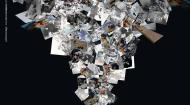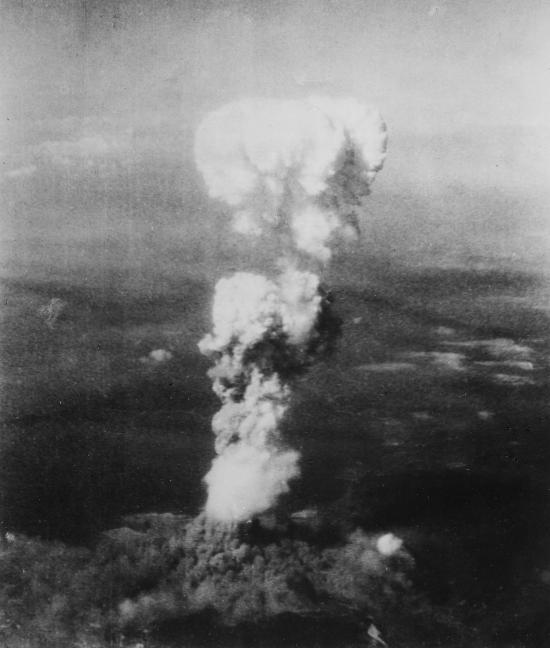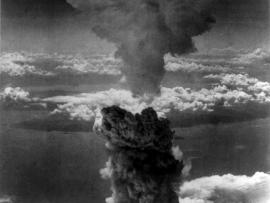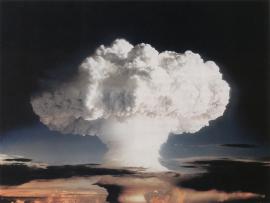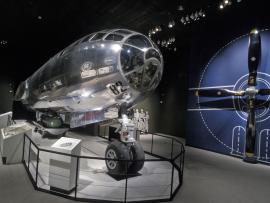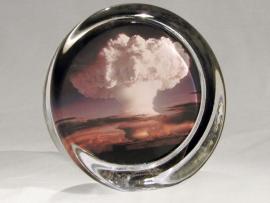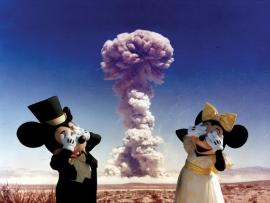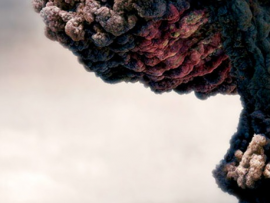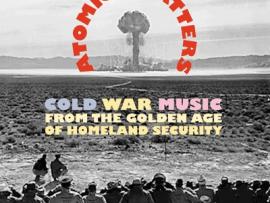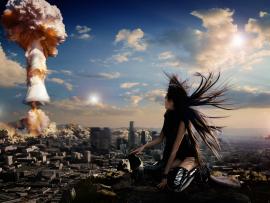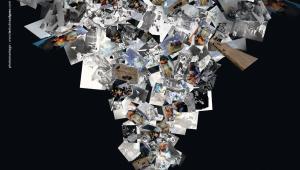OBSERVATOIRE DE L'IMAGINAIRE CONTEMPORAIN
Seeing the Bomb, Imagining the Future: Allegorical Vision in the Post-Cold War Nuclear Optic
The atomic age began officially on 4 August 1945, when the United States dropped the first nuclear bomb on Hiroshima, which it followed three days later by dropping a second bomb on Nagasaki.
The efficiency and scale of destruction strained the moral imagination as the two cities were immediately reduced to rubble and the combined death toll reached between 150,000 and 250,000 people within four months of the attacks. The spectacle of the blast would be compared, in Robert Oppenheimer’s words, both to the “radiance of a thousand suns” and to Shiva, the “destroyer of worlds.” 1 The almost unimaginable power of the weapon prompted President Truman to declare that possession of this “new force” was “an awful responsibility.” He concluded, “We thank God it has come to us, instead of to our enemies.” 2
Truman’s words anticipate the Cold War, to be sure, but, more important, they indicate the sense in which “the bomb” – as it was to become known – amplified a set of specifically modern anxieties about the future. Elsewhere we have referred to this sensibility as “modernity’s gamble,” the wager that the long-term dangers of a technology-intensive society will be avoided by continued progress. 3 Possession of the “ultimate weapon” raised the stakes to the highest level while motivating strategies of and questions about control. These anxieties had to be managed, and so cultural conventions emerged to address the fact that the prospect of nuclear annihilation seriously complicated society’s ability to imagine a future defined by progress rather than catastrophe.
These anxieties had to be managed, and so cultural conventions emerged to address the fact that the prospect of nuclear annihilation seriously complicated society’s ability to imagine a future defined by progress rather than catastrophe.
The task obviously involves problems of representation. War has always confounded representation, but it became especially problematic in the wake of atomic warfare: the near-total separation of the agents and victims of destruction, as well as the utter totality of destruction itself, were the province of science fiction. Initial representations of the explosions make the point. No images of the explosions were released by the military until 11 August, and even then not a single U.S. newspaper put the images on its front page. Both Time and Life featured photographs of the explosions in their 20 August issues, but in each instance they framed the images in a rhetoric of ambivalence. Time mitigated the scale of the explosions by using 2" × 4" photographs but triangulated them with a picture of Prometheus, who gave fire to humans only to suffer eternal punishment.4 The caption read, “Progress has a price.” Life provided full-page photographs of the two explosions, but prefaced them with a full-page “illustrator’s rendition” of the explosion at Hiroshima, showing clouds of dust expanding over the recognizable city, with the plane flying away from the explosion in the background. For Life, which otherwise relied upon the symbolic power of photographic realism, these photographs needed to be contextualized as an ordinary act of war that could fit within the traditional genre of military art. Subsequent “before” and “after” aerial photographs of the bombing reinforced the point, visually obscuring the devastating magnitude of the destruction, even as the text noted, “The atomic bomb had blown three-fifths of Hiroshima off the face of the earth.” 5
Thus, the initial visual representations of atomic warfare were artistically modest, morally ambivalent, tilted toward abstraction and ethical justification, and not yet anchored in one medium or image. Much of this would change as the initial images of the explosions were transformed in the public imaginary from grainy, ill-defined clouds of smoke into what today we recognize as the iconic image of the “mushroom cloud.” 6 As time has passed, however, it is apparent that the icon has been articulated through different optics for negotiating the anxieties attendant to modernity’s gamble. Initially, the icon anchored a “Cold War optic” that relied on a symbolic modality consistent with the aesthetic and political assumptions of high modernism; subsequently, it has been used to develop a “post–Cold War optic” that relies on an allegorical modality working against or beyond those assumptions. In what follows we identify the chief characteristics of each perspective and then conclude with some thoughts concerning the implications of this cultural shift for imagining the future.
Thus, the initial visual representations of atomic warfare were artistically modest, morally ambivalent, tilted toward abstraction and ethical justification, and not yet anchored in one medium or image. Much of this would change as the initial images of the explosions were transformed in the public imaginary.
The Cold War Nuclear Optic
As the end of the Second World War morphed into the Cold War, the iconic photograph of a sailor kissing a nurse in Times Square became the image of a nostalgic past and another “return to normalcy,” while the explosion of the mushroom cloud over Nagasaki became the icon for a forward-looking age of nuclear anxiety that included the Doomsday Clock, “duck and cover” drills for school children, Civil Defence shelter signs, promotional journalism for the nuclear arsenal, and so on. Photographs function rhetorically as icons in large measure because they eloquently negotiate key cultural tensions by managing multiple transcriptions or patterns of identification. From this perspective, the image of the mushroom cloud embodied a Cold War nuclear optic activated by the coordination of three key features of design: the structured absence of death and destruction, the formal perfection of the explosion, and the containment of the bomb within a closed circuit of military control. 7
The Hiroshima (figure 1) and Nagasaki (figure 2) photographs were oriented toward such an optic. Absent any referent to people or culture per se, the photographs underscore the unleashing of a natural force beyond imagination even as they mask the devastating effect that it had on the ground. Indeed, what we see in each instance is not the explosion itself, but its after-effect. Thus, the iconic image simultaneously displays and veils the destructive force wrought by the explosion. The mushroom cloud is unmistakably the real effect of the weapon detonating, and yet it completely displaces the scenes of human destruction that also are the real effect – and the primary intention – of the weapon. This absence of human suffering is consistent with the viewer’s experience, which mutes moral responsiveness, as any sense of cause, proportion, or complicity is obliterated by the incredible power unleashed from a single bomb. Hundreds of thousands could be dying below, but the viewer sees only a sublime spectacle of technological achievement and prowess, even as its moral costs are erased.
This vantage was matched by the formal perfection of the mushroom cloud. We see it clearly in the photographs of the Nagasaki explosion, in which the visual aesthetic coordinates multiple registers of representation. On the vertical axis we have the dark billowing plume that extends from outside of the bottom of the frame through an interceding cloud at the mid-point of the image, from which it blossoms forth as a tapered and almost perfectly symmetrical “mushroom.” That the lower trunk of the plume is dark and opens up into a brighter and whiter cloud invokes a compelling balance to the grey-scale tones of the image, locating the ultimate expression of the force of the explosion in the more positive glow and dispersion of light.8 By the time we get to the photographs that emanate from the subsequent tests in the Marshall Islands and at Yucca Flats, the symmetrical perfection of the explosions is even more pronounced (figure 3). In contrast to the obliteration occurring underneath the blast, the explosion became a work of art.
The artistry evident in images of the nuclear tests reinforced the third element in the Cold War nuclear optic, which was an emphasis on the containment of the bomb within a closed circuit of military control. The hundreds of photographs of nuclear explosions that appeared in publications such as Life in the 1950s and 1960s accented its custodianship by scientists and technicians within a disciplined, well-organized military-industrial complex. 9 Indeed, full interpretation of the iconic image requires that it be seen as an anchor for a host of other images of the equipment, testing facilities, technocratic personnel, and military command centres that made up the nuclear weapons complex and functioned, in turn, to signify the system of control. None of these banal, often posed photographs of inert materials, institutional settings, and anonymous officials would have had much purchase visually but for the iconic image of the blast, and yet they provided a secondary resonance as markers of the system’s ability to prevent a dystopian future.
It is interesting to note how the ambiguous temporality of the nuclear icon became emblematic of this closed circuit, which, in turn, was reinforced by the formal perfection of the bomb enveloping a structured absence. Each iteration of the icon referred back to the original symbolic representation of “the bomb,” which became the photograph from Nagasaki with its now easily recognizable mushroom cloud. After all, the significance of the blast derived from the historical fact of its use, and so each “test” of the technology was a symbolic extension of the originating event. Because each subsequent blast was a test, however, it served to lessen the sense of actual, historically specific harm, including the original devastation. Moreover, the Nagasaki image came to refer forward to the subsequent refinement and futurity of the technology, rather than backward to the atrocity it had effected. Every image of a nuclear blast now was a march forward from that prior event on the road to progress and security. Thus, all of the images created a circle of events that displaced ordinary historical time on behalf of a modern myth, while each image was predominantly an assertion of the bomb’s power within a specific but largely abstract space. The images themselves thus constituted a closed circuit of reference – each referring to the others – that helped to efface memory, ensure moral insularity, and reinforce compliance with Cold War doctrine.
A photograph that began as a blurred mark of military victory in a world war was thus transformed into an icon for the normalization of a new technology and a new political order. Images of the suffering caused by the bomb were to appear, albeit very infrequently, but their moral purchase was consistently overshadowed by the photographs of aesthetically contained, technocratically controlled nuclear test explosions that precluded any experience of atrocity or catastrophe. The ever-more-perfect mushroom clouds represented enormous destructive power – but in the abstract. Indeed, the nuclear icon epitomized the abstraction characterizing modernist aesthetics; it harnessed not only the power of the atom but also the dominant cultural mentality of the time to symbolize the magnificence of American power. A photographic image recorded the real, and in doing so it seemed to enact a perfect concordance between event and representation, individual sign and universal reference, single occurrence and systemic totality. As Paul de Man has noted, this is the modality of the symbol, which in turn became a pillar of modern aesthetics and was aligned with the modern state. 10 Because it emerged during the high point of American modernism, an iconic image of mass destruction came to represent a comprehensive human condition on behalf of modern civilization’s capability for improvement. With the passage of time, this would prove too good to be true.
The Post-Cold War Nuclear Optic
A thorough analysis of the icon of the mushroom cloud would require attention to the wide array of ways in which the photograph was appropriated throughout the Cold War era by retailers, advertisers, artists, cartoonists, filmmakers, advocates, and the many other participants in the patterns of circulation that constitute public culture. 11 Our concern here is limited to how the Cold War nuclear optic has undergone something of a transformation in the post–Cold War era. We should be clear in noting that our usage of the phrase “post–Cold War” does not imply anything like “the end of history” thesis so popular among neo-conservatives in the 1990s, but instead references a transitional sensibility born of – and thus connected to – but moving beyond the Cold War era.
How the Cold War nuclear optic has undergone something of a transformation in the post–Cold War era.
The main event marking U.S. history since the fall of communism is without a doubt the 9/11 attacks on the World Trade Center and the Pentagon. And it is not at all surprising in this context that the black-and-white image of “the bomb” would become increasingly dated. It is surprising, however, that images of “the bomb” have been largely absent from the mainstream media despite the emergence of terrorism as a new geopolitical threat that includes regular discussion of “weapons of mass destruction,” renegade scientists, nuclear weapons production by avowed adversaries in the Middle East, the smuggling of enriched uranium and nuclear warheads, and tactical nuclear attacks on U.S. cities executed by “dirty bombs” delivered via shipping containers. One wonders why the mainstream media have not availed themselves of a conventional image.
The first, and most obvious, answer is that, as with any period of transition, the prior optic retains some measure of dominance in public representation. In this regard, the controversy over the 1995 Enola Gay exhibition at the Smithsonian National Air and Space Museum is particularly illustrative even though it antedates 9/11. 12 The original exhibition was scheduled to include documentation of the suffering caused by the bomb, whereas the eventual “compromise” restored the structured absence of the Cold War optic. Tellingly, in place of depictions of the human damage wrought by the bomb, the exhibition offered documentation on the making of the exhibit – a technocratic diversion that reinforced a closed circuit of administrative control (presented as competent problem solving) and returned the public gaze to the sleek surfaces of the plane (figure 4). Thus, the exhibition, coming not only at the fiftieth anniversary of the Hiroshima bombing but also seven years after the fall of the Soviet Union, set out to move past the confines of the Cold War optic, and then was bullied back into compliance with the symbolic register of that visual regime. 13
It seems sensible to conclude that a similar structured absence is being enacted now: precisely as threat increases, the most vivid reminder of the weapon’s power is not shown, because the first impulse is to rely on the prior optic, even at the expense of its iconic image. 14 (And, tellingly, other symbols, such as rockets and the three-oval atomic diagram, have been used.) We think that this explanation is too neat, however, and so we want to suggest a second, overlapping answer to the question, which is that the relative absence of the iconic image is one part of a new, post–Cold War optic that marks a shift in public consciousness regarding nuclear weapons and, perhaps, modern catastrophe more generally.
Despite being noticeably absent in precisely the places where we would expect to see it, the iconic image is reappearing elsewhere, albeit in new configurations that suggest the emergence of a different optic for visualizing nuclear war. No longer tied to the documentary conventions of traditional photojournalism, these images play with an allegorical modality symptomatic of periods of transition. The turn from symbol to allegory includes moving from realism to semiotic excess, from coherence to fragmentation, from universality to temporality, from discrete arts to mixed media, and from stable meaning to multiple interpretations. 15 Such changes are more likely to become evident among artists (and advertisers) than in the mainstream press, but they can influence public culture nonetheless. So it is that images of “the bomb” now are showing up with some frequency in what might be considered odd places – at least from the perspective of the Cold War national security state.
The turn from symbol to allegory includes moving from realism to semiotic excess, from coherence to fragmentation, from universality to temporality, from discrete arts to mixed media, and from stable meaning to multiple interpretations.
Consider, for example, The Atomic Store, which began as a distributor for a 1995 documentary film on nuclear weapons testing but now offers t-shirts, coffee mugs, key chains, and other collectibles festooned with mushroom clouds or radiation symbols, as well as a book titled How to Photograph an Atomic Bomb. 16 These are more than mere collectibles from another era. A case in point is the “Small Atomic Gift Box,” which is a small white box tied with yellow ribbon bearing the atomic radiation symbol. One might want to use it as a container when giving the “Ivy Mike Paperweight” as a present (figure 5). These and the related items all follow a common form: the nuclear iconography is miniaturized and given an ironic spin, typically by its “fusion” with the decorative arts of everyday life. “Containment” thus acquires new meaning, as the images themselves are encased in small decorative objects that allow us “to bring the atomic era into [our] home.” Nuclear terror is addressed by reframing the “the bomb” through the combination of laughter and awareness that is often used to cut things down to human scale.
Although representations of nuclear weaponry had been a part of popular culture from the mid-1940s forward, important differences are evident in the most recent appropriations. Throughout the Cold War era, atomic “branding” was defined by the culture of control and the myth of progress. Placing photographs of a mushroom cloud on a Las Vegas postcard, naming a high school team “the Atomics,” and creating “Atomic Fireball” candy domesticated the image through the conventions of popular culture while reinforcing a sense of security. 17 Surely one would not treat a serious threat with such banal imagery unless one were convinced that it was already part of a universal and progressive march forward. Likewise, the association was made to tap into the symbolic power of the nuclear arsenal: this city, team, or company was claiming that it had the efficiency and impact of the most awesome example of modern civilization – again, a claim that could be made only if the destructive consequences were assumed to be under control amidst assured progress.
More recently, however, representations of the mushroom cloud have been historicized and individualized, thus marking a shift from universal to temporal, situated references. As with The Atomic Store, images from popular culture are increasingly ironic and transgressive, while artistic use is more tilted toward odd associations and cultural commentary than the earnest, admonitory realism of anti-nuclear advocacy. The artist Max Papeschi, for example, couples mushroom clouds with Disney characters (figure 6). Mickey and Minnie, who are “Just Married,” cover their eyes while the mushroom cloud rises behind them in the desert. 18 The “see no evil” association is obvious, as is the commitment to pursuing private life with a wilful disregard for any collective complicity with nuclear destructiveness. The relationship with the bomb is still predominantly visual, but now moral blindness is foregrounded. As the cartoon characters are themselves creatures of the spectacle, and since Disney did its share to promote controlled use of the bomb, their appearance here is particularly apt. 19 Note, too, that the characters are suitably gendered: Minnie with her perpetual smile, and Mickey with his tuxedo and more sombre expression. Each thus models a different side of coordinated regimes of official and domestic control.20
Even though “the bomb” remains at the centre of Papeschi’s composition, it is in the background, diminished and perhaps tactical, and in any case it is framed in a manner that reveals society (and thus the audience) rather than featuring only the sublime grandeur of the explosion itself. Other appropriations go further still in cutting away at the formal aesthetic. For example, a theatrical poster for a play about radiation sickness features one part of a mushroom cloud, a trisection close enough that the fire inside is visible (figure 7) 21 This vertical cross-section of the mushroom cloud is almost unique. The symmetry is still there, but also not there. Enormous power still is being released, but we can’t be as reassured about its being contained. The experience of the sublime is started but interrupted, with too much off-stage. What is then activated is a corresponding demand on the viewer’s imagination to supply the rest of the formal image, and perhaps the rest of the story. Not surprisingly, the play being advertised provides part of that story – and it is a story not of progress but of hidden damages.
This unravelling of the modernist narrative is part of a larger historicizing of the Cold War and, with that, of the modern myth of progress. The cover of the CD Atomic Platters, for example, features a photograph of military spectators sitting on bleachers in the desert as they look at a small mushroom cloud in the centre distance (figure 8) 22 . The subtitle “Cold War Music from the Golden Age of Homeland Security” argues for the continuation of the national security state past the end of the Cold War. But the Cold War here is given new inflection as well, for although the state apparatus is included in the picture, everything has been scaled down to the level of ordinary life. The brass sit there as if at a small-town high-school football game, and again the bomb may be a tactical weapon. The structured absence, formal perfection, and circuit of control are still there, but diminished so as to give a sense of fallibility. What was a picture of the future has become an image of (and sounds from) the past; in place of the original songs, however, the album (and related Web archive) suggest a future not enchanted by “the bomb,” although still subject to the dual threat of both the weapon itself and other excessive investments in national security.
Like other attempts to rework the image of the bomb, this usage suggests how “the past” served as a strategy of containment in the Cold War Optic. Because images of “the bomb” were high-quality colour photographs from controlled tests undertaken as part of the advancement of nuclear weapons technologies, the grainy black-and-white images from the actual use of the bomb as a weapon of mass destruction were visually “past.” The actual destructiveness of the bomb was thus safely interred in a prior time that had all the marks of a historical archive. Even recent exhibitions intended to provide better public documentation of the actual scale of destruction cannot escape this trap, and so Hiroshima and Nagasaki remain objets d’archive rather than harbingers of a possible future. 23 Even so, such exhibitions may contribute to moving past the old optic, for they turn the viewer’s gaze from the cloud to the obliteration that occurred on the ground.
Other appropriations take the next step, which is to move ground zero not only from past to future, but also from there to here. The artist Cai Guo-Qiang, for example, creates photographs of himself releasing smoke in the shape of a mushroom cloud before places such as the New York skyline or an abandoned building at a Nevada test site. 24 Taking the small, obviously fabricated version of the iconic image to historically specific locales is weirdly disorienting. Is this a record of what did happen or what might happen? Is it a memory or a prophecy? Why is the cloud so small and innocuous, while the settings are so deadly (the test site) or awful to contemplate (New York destroyed)? And how is a single individual capable of releasing a mushroom cloud? In these and other appropriations appearing across the spectrum of public artistry, the iconic image is still there, but now its once-formal perfection is fragmented or reframed, the structured absence regarding actual destructiveness is breaking down, and the circuit of control is shown both to include more of society than it is comfortable to admit and to be unlikely to prevent a nuclear attack.
To get a clearer sense of how a new optic might be emerging from the gradual deterioration of the old, one need look no farther than a New York Times story about the debut of fashion photography at the 2007 Miami Beach Art Photo Expo. Titled “Work With Me, Baby,” the article leads off with a photograph by fashion photographer Seb Janiak (figure 9). 25 The photograph, which very clearly puts “the bomb” back into the public eye, sat on the front page of the Times Web site for the better part of the day on which it appeared (12 December 2007) as an advertisement for the accompanying story – which, by the way, never once mentioned the photograph.
On its face, the photograph is both an artistic challenge to the prevailing optic of the Cold War image culture and something of a response to the contemporary anxiety about the immediate possibilities of nuclear war. In place of the structured absence, the target of destruction is now evident as we witness the immolation of a city. The formal perfection of the explosions is retained in some measure but also complicated by there being multiple explosions, no one of them in the centre of the frame, and they also appear miniaturized and perhaps retouched. Instead of a single, iconic image dominating the pictorial space, now the bombs are but differentiated events within a larger landscape. Notice also that culture (the city) and nature (the promontory from beyond which the viewer witnesses the scene) are here separated from one another, rather than unified as in the eye-level views of the high blasts in the older photographs. 26 The mood is different as well, as the cool, richly saturated blue sky dotted with puffy white cumulus clouds stands in stark opposition to the Cold War optic, which featured either high-contrast black-and-white photographs that underscored the abrupt and violent disruption of the force of the bomb or colour photographs heavily overcast in dominating red and orange hues that signified the overwhelming heat (and beauty) of the blast; now the image is given an ironic tint with the artificial colours of a tourist’s postcard. Finally, there are not one but multiple explosions (and perhaps more coming), which obviously operate outside of the closed circuit of military control.
The key point, of course, is that the prior Cold War nuclear optic is no longer adequate (if it ever was) to the potential problems we face – and yet those problems have not gone away for the absence of a compelling image (just as the problem of torture at Abu Ghraib was no less serious before photographs of its existence turned public attention to it). And so what is the newer optic that we are being offered and what are its implications? The answer here is a bit more difficult to discern, but we have to start by noticing that the change involves a challenge not only to the Cold War nuclear optic but also to the realist aesthetic that underwrites the documentary assumptions of photojournalism in general. Janiak’s work depicts a possible, not actual, event framed from the perspective of a not-too-distant future. It is thus inherently allegorical, a fictional and hyper-realistic pastiche of at least six competing and overlapping codes.
First is the code introduced by the bomb itself. The explosions could be directly out of the Cold War optic, albeit having being reduced by their displacement across the landscape. They do not dominate, however. If anything takes up the pictorial space, it is the city: a modernist codification reminiscent of the work of survey geographers of the 1950s and 1960s, it offers an almost grid-like representation of a complex social and political event or environment for the benefit of institutional observation and control from a safe distance. The cityscape then is sutured with a version of the sublime epitomized by works such as Casper David Friederich’s Der Wanderer über dem Nebelmeer – a significant allusion, since the viewer has been returned to an actual precipice that anyone might access rather than the invisible platform in the sky that had been an important feature of the technological sublime in the Cold War optic. The individual sitting in the foreground, high above the cityscape, invokes three additional – and competing – codes for viewing the photograph. First, we have a high-fashion model, ultra-modern and aloof, someone we are more likely to see in the pages of Vogue than meet face to face in a disaster. Additionally, however, she is encoded as the gothic, post-human superhero whom one might find in a futuristic graphic novel, looking down on the dystopian city. At the same time, however, she bears the markings of an Asian heritage, and thus stands as something of a ghost from the beginning of the atomic age. 27
The combined effect of this surplus of signification is a picture of excess and ambivalent viewership, but, more to the point, it marks a clear disruption in the narrative of progress animated by the Cold War. The photograph – and here we need to call attention to the fact that it is clearly a hybrid image, simultaneously a photograph and an illustration – invokes a sense of the sublime, but the source of that sublimity is no longer “the bomb” and its magnificence or ferocity. Rather, it seems to emanate from the cityscape and its capacity as a technology to withstand the multiple explosions as if they were an ordinary and everyday event. It is, in short, a visual rhetoric of catastrophe, but not in the modernist sense of thorough and utter destruction. Rather, it is an allegory of catastrophe that challenges both the image culture of the Cold War and the more recent cultural amnesia.
It is an allegory of catastrophe that challenges both the image culture of the Cold War and the more recent cultural amnesia.
The allegorical alternative that it offers seems to draw on the world of high fashion, a point underscored by the title of the accompanying article, “Work With Me, Baby.” These are the words of avant-garde fashion photographers working fast and furious to capture a soft-porn aesthetic that can be published in magazines suitable for public consumption. And so, one has to wonder, is this image one step closer to Walter Benjamin’s terrible prophecy that humankind’s “self-alienation has reached the point where it can experience its own annihilation as a supreme aesthetic pleasure”? 28 Or is it a cautionary tale designed to warn us against our own political indifference? After all, it is unlikely that either fashion models or photographers will save us from nuclear war.
Rather than perverse viewership, the fashion model/superhero could well be an inversion of Walter Benjamin’s allegory of the “Angelus Novus.” 29 According to Benjamin, the angel’s back is turned to the future as he contemplates the wreckage of history accumulating from the storm of progress blowing from “Paradise”; by contrast, the postmodern angel observes the wreckage occurring within paradise itself – Los Angeles in some future and perhaps not-distant time. The viewer is positioned in the past, temporarily untouched by actual explosions radiating upward from the city, but still on the precipice. The mood is apocalyptic, a moment of revelation.
But of what? Not, it seems, of atrocity or catastrophe as we ordinarily understand those terms. In place of the body in pain, we see a fashion model. And yet the image does make nuclear war thinkable, and not as a fantasy of grand strategy but as a site of victimhood and of what happens after that. If there still is a structured absence – and there is – it is within a scene that has become mildly, disturbingly parodic, which is another sign that assurances of perfection and control on behalf of progress are things of the past.
Conclusion
Modernity always is about the future, and modern societies will develop in one direction or another according to the collective imagination of what lies ahead. In summarizing debate about the actual bombings at Hiroshima and Nagasaki, Laura Hein and Mark Selden remark, “Discussion of the bombings is as much about visions of the future as it is about judgments of the past.” 30 This observation extends with additional force to the image of “the bomb.” Identified as the epitome of technological prowess, the bomb automatically complicated modernity’s narrative of being at the vanguard of continuous progress. “The bomb” was both the supreme case of harnessing nature and a weapon explicitly understood to be able to send humanity “back to the stone age.” Modernity had long been accompanied by nostalgia regarding the loss of traditional settings, mores, and relationships, but this was different: not the costs of moving forward but a comprehensive return to the time before civilization. Perhaps the universalizing logics of modernism could not sanction another, more flexible imagination: one was either headed to an ever-expanding future or starting over, either drawing on powers outside of history or returning to a condition before historical time began. In any case, the bomb was met with both awe and anxiety, and that anxiety was so extensive as to raise the question of whether there would be a future at all. Thus, the Cold War optic emerged as the state, the press, and ordinary people attempted to maintain a sense of control on behalf of progress.
That future was limited to a narrow view, however: one in which the weapons were never used. Anything else was not an alternative future so much as the end of civilization. Even the parodic masterpiece Dr. Strangelove ends on this point: rather than facing the impending nuclear Armageddon, the military and political leaders fantasize about living underground with beautiful young women (not their wives) to breed a master race. It wasn’t likely to happen, of course, and even if it did the vision of a ruined planet populated by hot-house Nazis is not exactly progressive.
More recent use of nuclear imagery to articulate a post–Cold War optic saves the future by restoring a more explicit sense of temporality that includes both rupture and continuation. Catastrophe still looms, but civilization may continue even so. (One parodic Web site provides “Top Ten Tips on Throwing a Party During a Nuclear Holocaust.” 31) Instead of invoking the annihilating power of nature, bombs past, present, and future are now placed within a history in which people will need to muddle through. Instead of a seemingly transparent photograph of universal forces, the images now come marked as allegorical works whose obvious artifice prompts reconsideration of both what has happened and what might occur. Of course, one could face the-bomb-in-history through gritty realism, but that is not essential and can lead to its own trap. The better approach seems to be to subvert any attempt to anchor the meaning of the image in a single point of view, and instead to prompt a more engaged viewership. That, along with a restored sense of human scale, articulates a fragmented present within an uneven historical narrative, but it also provides a wider range of resources for imagining alternate futures.
Instead of invoking the annihilating power of nature, bombs past, present, and future are now placed within a history in which people will need to muddle through.
As long as nuclear weapons exist, it may be that humanity lives at the precipice. At least now, however, some are willing to consider that the outcome depends on more than the system of control. It might, for example, depend on those who are looking at the iconic image, on whether they will refuse an easy combination of enchantment and amnesia – or irony and cynicism – and to what extent they will settle for a society pitched toward destruction. It would be far better to face up to possible catastrophes and the futures that could still occur than one day to be looking upward together, stunned and dazzled at the very moment of being blinded by the blast.
- 1. Robert Jungk, Brighter than a Thousand Suns: a Personal History of the Atomic Scientists, trans. James Cleugh (New York: Harcourt, Brace & World, 1958), 201; “J. Robert Oppenheimer on the Trinity Test,” Atomic Archive.
- 2. President Harry S. Truman, “Radio Report to the American People on the Potsdam Conference,” 9 August 1945, Public Papers of the Presidents, Harry S. Truman, 1945–53. Quoted in “Atomic Age,” Time, 46 (20 August 1945), 29, as part of the caption to its first reproduction of images of the explosion of bombs over Hiroshima and Nagasaki.
- 3. Robert Hariman and John Louis Lucaites, No Caption Needed: Iconic Photographs, Public Culture, and Liberal Democracy (Chicago: University of Chicago Press, 2007), 243–45.
- 4. “Atomic Age,” 29.
- 5. “Atomic Bomb and Soviet Entry Bring Jap Surrender Offer,” Life, 19 (20 August 1945), 31.
- 6. We are not the first to address the visual representation of “the bomb” and are indebted to the good work of Vincent Leo, “The Mushroom Cloud Photograph: From Fact to Symbol,” Afterimage (September 1965), 9. We see our consideration of the movement of the usage of the iconic photograph from “symbol” to “allegory” as an extension of his work. See also Peter Hales, “The Atomic Sublime,” American Studies, 32 (1991), 5–31, and “Imaging the Atomic Age: Life and the Atom,” in Looking at Life Magazine, ed. Erika Doss (Washington, D.C., and London: Smithsonian Institution Press, 201): 103–22; David Nye, American Technological Sublime (Cambridge: MIT Press, 1994), 225–56.
- 7. The analysis here is drawn from Robert Hariman and John Louis Lucaites, “The Iconic Image of the Mushroom Cloud and the Cold War Nuclear Optic,” in Picturing Atrocity: Photography in Crisis, ed. Geoffrey Batchen, Mick Gidley, Nancy K. Miller, and Jay Prosser (London: Reaktion Books, 2012), in press.
- 8. On the significance of lightness and darkness as archetypal metaphors, see Michael Osborn, “Archetypal Metaphor: The Light-Dark Family,” Quarterly Journal of Speech 53 (1967): 115–26.
- 9. Film documentaries were an important part of this PR effort. See Bob Mielke, “Rhetoric and Ideology in the Nuclear Test Documentary,” Film Quarterly 58 (2005): 28–37. Mielke notes that the “central ideological thrust of all these test documentaries” was that “conducting and observing nuclear explosions is primarily about scientific research, not military preparedness” (34). See also Nathan S. Atkinson, “Newsreel as Domestic Propaganda: Visual Rhetoric at the Dawn of the Cold War,” Rhetoric & Public Affairs, 14 (2011): 69–100. Garry Wills documents how management of the bomb distorted U.S. governance much more broadly as it became the centrepiece of the national-security state, in Bomb Power: The Modern Presidency and the National Security State (New York: Penguin, 2010), esp. 137–236.
- 10. “In the world of the symbol it would be possible for the image to coincide with the substance, since the substance and its representation do not differ in their being but only in their extension: they are part and whole of the same set of categories. . . . Their relationship is one of simultaneity, which, in truth, is spatial in kind, and in which the intervention of time is merely a matter of contingency, whereas, in the world of allegory, time is the originary constitutive category.” Paul de Man, “The Rhetoric of Temporality,” in Interpretation: Theory and Practice, ed. Charles S. Singleton (Baltimore: Johns Hopkins University Press, 1969), 190. On the state and modernism, see James C. Scott, Seeing Like a State: How Certain Schemes to Improve the Human Condition Have Failed (New Haven: Yale University Press, 1998).
- 11. See for example, Paul Boyer, By the Bomb’s Early Light: American Thought and Culture at the Dawn of the Atomic Era (Chapel Hill: University of North Carolina Press, 1984); Spencer R. Weart, Nuclear Fear: A History of Images (Cambridge: Harvard University Press, 1988); Joyce Eans, Celluloid Mushroom Clouds: Hollywood and the Atomic Bomb (Boulder: Westview Press, 1998). See also Vicki Goldberg, The Power of Photography (New York: Abbeville Press, 1991), 148–52; and Peggy Rosenthal, “The Nuclear Mushroom Cloud as Cultural Image,” American Literary History 3 (1991): 63–92.
- 12. See Edward T. Linenthal and Tom Engelhardt (eds.), History Wars: The Enola Gay and Other Battles for the American Past (New York: Holt, 1996); Bryan Hubbard and Marouf A. Hasian, Jr., “The Generic Roots of the Enola Gay Controversy,” Political Communication 1 (1998): 497–13; Bryan C. Taylor, “The Bodies of August: Photographic Realism and Controversy at the National Air and Space Museum,” Rhetoric & Public Affairs 1 (1998): 331–61. A bibliography on the controversy is available at History on Trial, The Enola Gay Controversy.
- 13. The historical and technocratic conventions continue to be employed during this transitional period. See for example “The Bomb Chroniclers,” New York Times, 13 September 2010, which features the professionals who photographed the atomic tests. One of the lead photographs for the story shows a small mushroom cloud in the background, with silhouetted photographers and their equipment in the foreground. The inclusion of the photographers clearly breaks up the atomic sublime and demotes the iconic image, but still features technical skill in place of moral reflection.
- 14. For a rare use of the iconic image to confront the issue of post 9/11 nuclear security, see the large, above the fold mushroom cloud accompanying the editorial titled “A towering cloud of uncertainty: Candidates give little attention to the nuclear issue,” Chicago Tribune, January 18, 2008, 21.
- 15. For more extensive discussion of the trope, see Robert Hariman, “Allegory and Democratic Public Culture in the Postmodern Era,” Philosophy and Rhetoric 35 (2002): 267–96. See also Brian Wallis, “The Allegorical Impulse: Toward a Theory of Postmodernism,” in Art After Modernism: Rethinking Representation, ed. Brian Wallis and Marcia Tucker (New York and Boston: New Museum of Contemporary Art and D. R. Godine, 1984), 203–35.
- 16. The Atomic Store. Other online gift shops are available as well, such as the one at the National Museum of Nuclear Science and History.
- 17. Goldberg documents a number of commercial appropriations in The Power of Photography, 150–51.
- 18. See Max Papeschi, “Just Married” and “Follow the White Rabbit”.
- 19. “In a 1956 Disney Productions film and book, Our Friend the Atom, a hideously ugly and huge ‘atomic Genie’ threatens humanity, represented by the fisherman, who however uses his wits to trick the genie back into the bottle (a nuclear reactor)” (Rosenthal, “Nuclear Mushroom Cloud,” 87). One marvels at Disney’s reworking of the fact that fishermen in the Marshall Islands were irradiated by nuclear tests.
- 20. Wendy Kozol, Life’s America (Philadelphia: Temple University Press, 1994), esp. 51–96.
- 21. See Louis Slotin Sonata, Red Orchid Theatre.
- 22. See http://www.atomicplatters.com/.
- 23. See “Hiroshima: Ground Zero, 1945” at the International Center for Photography.
- 24. Cai Guo-Qiang, “The Century with Mushroom Clouds: Project for the 20th Century,” 1996, (no longer available online). The photographs are taken by Hiro Ihara. The work predates 9/11 but was on display in a recent retrospective at the Guggenheim in Manhattan. The Washington Post caption for the slide of the skyline (which includes the Twin Towers) put the work in the context of 9/11.
- 25. Guy Trebay, “Work With Me, Baby,” New York Times, December 6, 2007.
- 26. For examples of such images, see Michael Light, 100 Suns: 1945-1962 (New York: Alfred A. Knopf, 2003).
- 27. We are indebted to Ned Gorman for this last observation.
- 28. Walter Benjamin, “The Work of Art in the Age of its Technological Reproducibility,” in The Work of Art in the Age of its Technological Reproducibility and other Writings on Media, ed. Michael W. Jennings, Brigid Doherty, and Thomas Y. Levin (Cambridge: Belknap/Harvard University Press, 2008), 42.
- 29. Walter Benjamin, “Theses on the Philosophy of History,” Illuminations: Essays and Reflections, ed. Hannah Arendt, trans. Harry Zohn (New York: Schocken Books, 1969), 257–58.
- 30. Laura Hein and Mark Selden, “Fifty Years after the Bomb: Commemoration, Censorship, and Conflict,” Economic and Political Weekly 32, no. 32 (9–15 August 1997): 2010.
- 31. Top Ten Tips on Throwing a Party During a Nuclear Holocaust, Newsicus Maximus, 20 May 2006. The Website www.newsicus.com is no longer online

